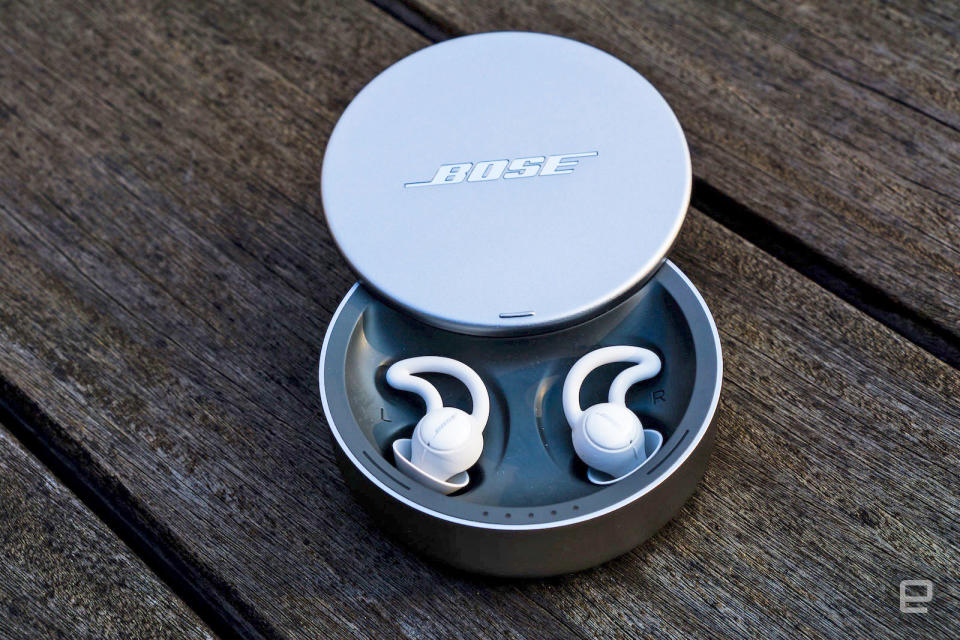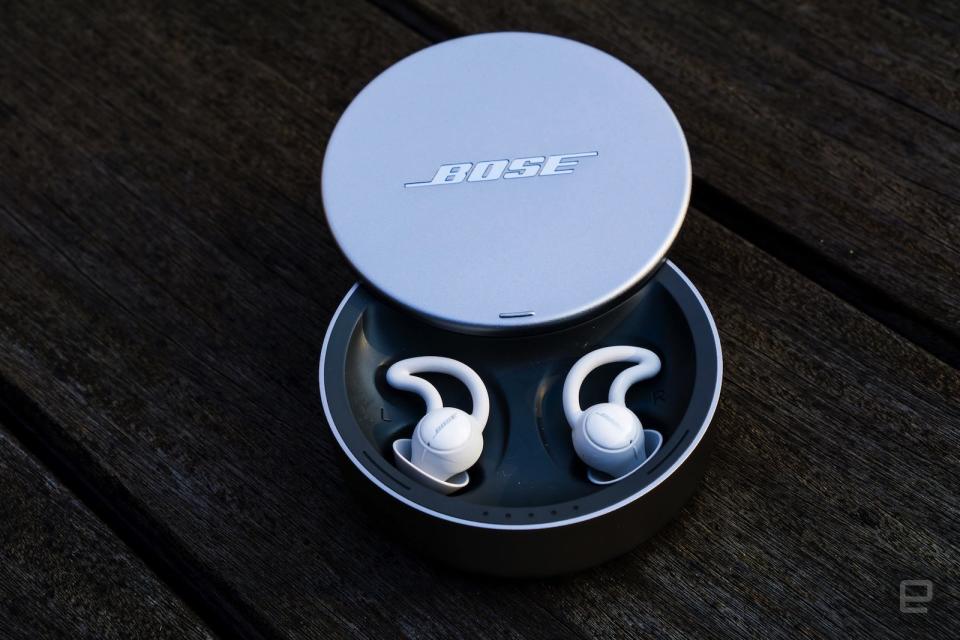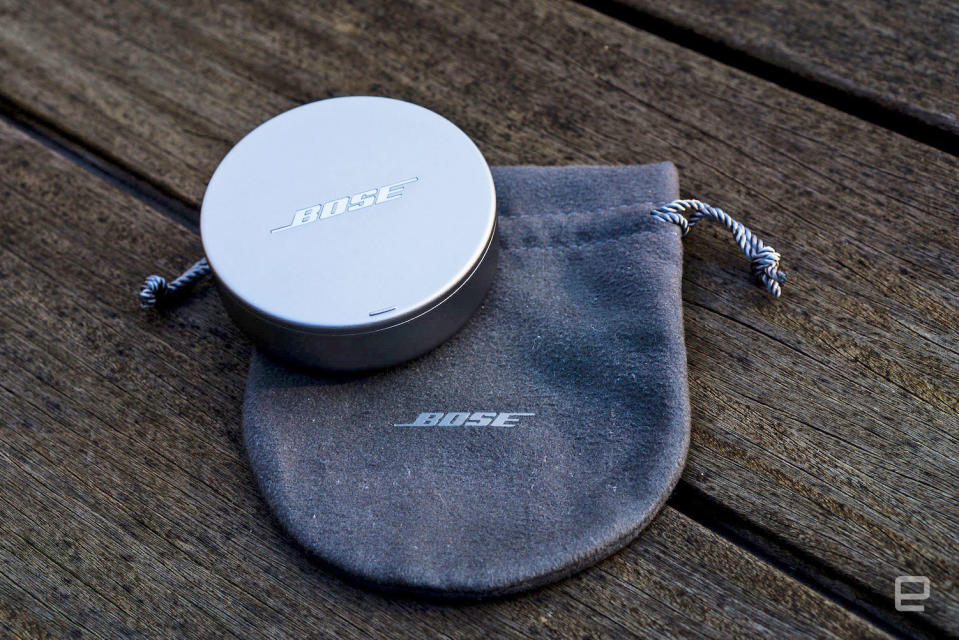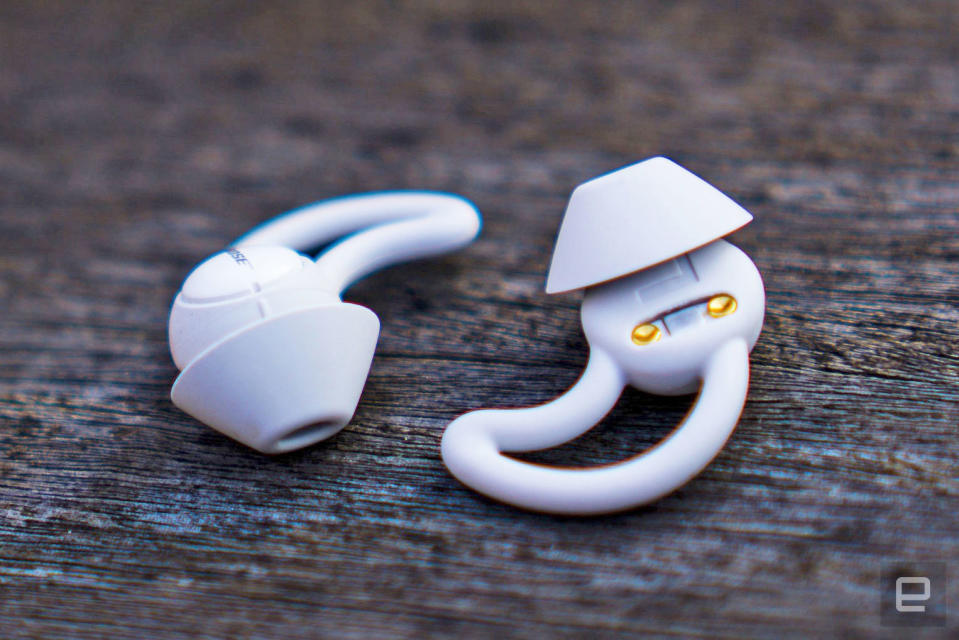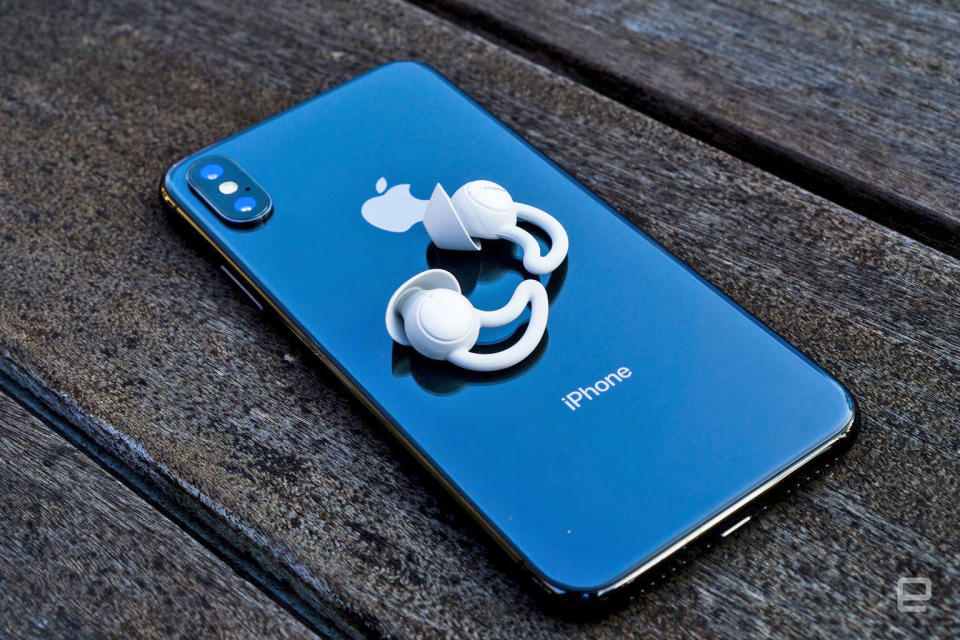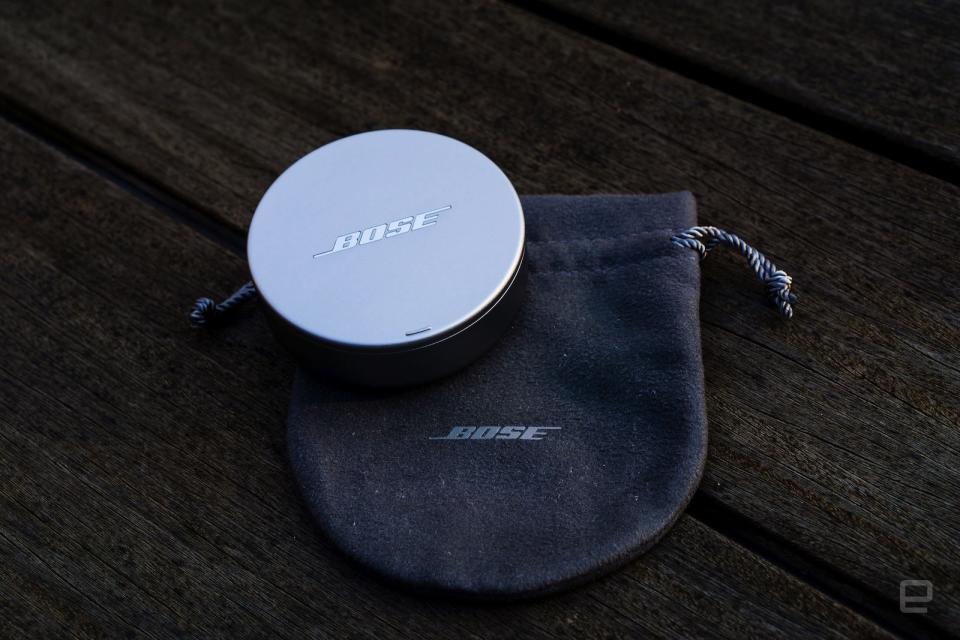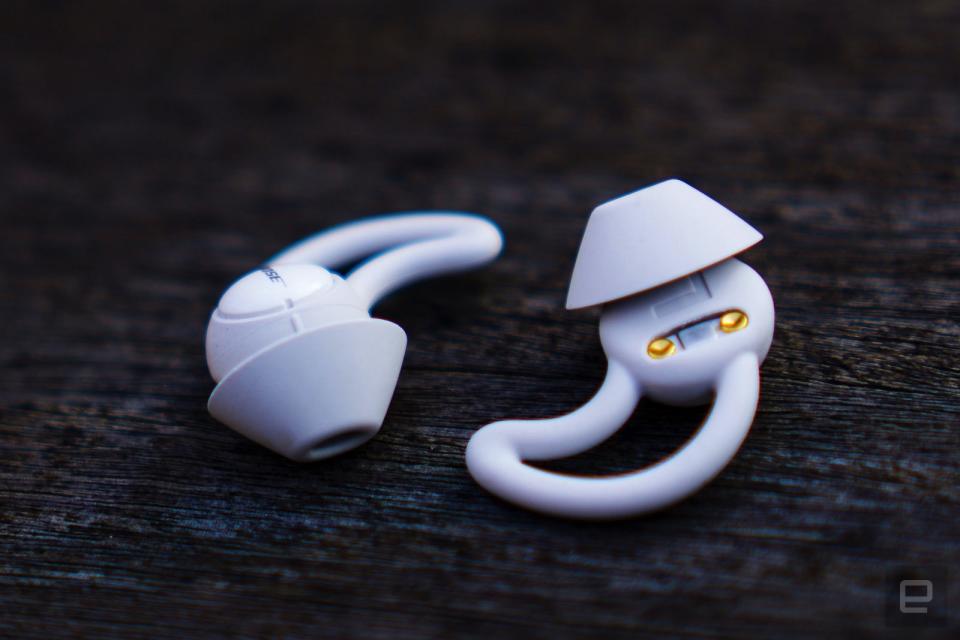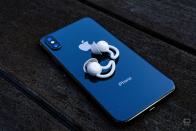Bose Sleepbuds review: Helpful but needs improvement
These pricey earbuds aren’t perfect, but they certainly help.
Bose, which is well-known for its quality (and pricey) audio equipment, went an interesting route with its latest piece of hardware. Two years ago, the company took to Indiegogo to gauge interest in a pair of noise-masking sleep earbuds. Essentially, customers paid to be part of the beta test and received hardware at up to a $100 discount. At the end of the campaign, the company had raised $450,320 -- more than 900 percent of its $50,000 goal -- so clearly there's a market for these. The Sleepbuds went on sale for $249.95 in June, and I was pretty much first in line to buy a pair at my local Bose store.
I've been a light sleeper all of my life, and living in a loud city for a decade wasn't exactly conducive to getting a good night's rest. I expected the situation to improve when we moved out to the semi-country, and it did for the most part. There was just one problem: My husband started snoring.
I tried a number of different things to deal with the sound: a loud white noise fan mixed with a white noise machine, a pillow over my head and the tried and true "constantly jabbing him every time he started snoring so that neither of us slept a wink" method (that last option was supremely unpopular in my house).
But in June, my husband took matters into his own hands and sent me a link to the newly released Bose Sleepbuds. After almost three months of continuous use, I'm ready to pronounce these the cure to my sleep ills... with some caveats, of course.
The Bose Sleepbuds are designed for one thing only: sleeping. These cannot play your music. At $249.95, that's a lot of money to drop on a single-function device.
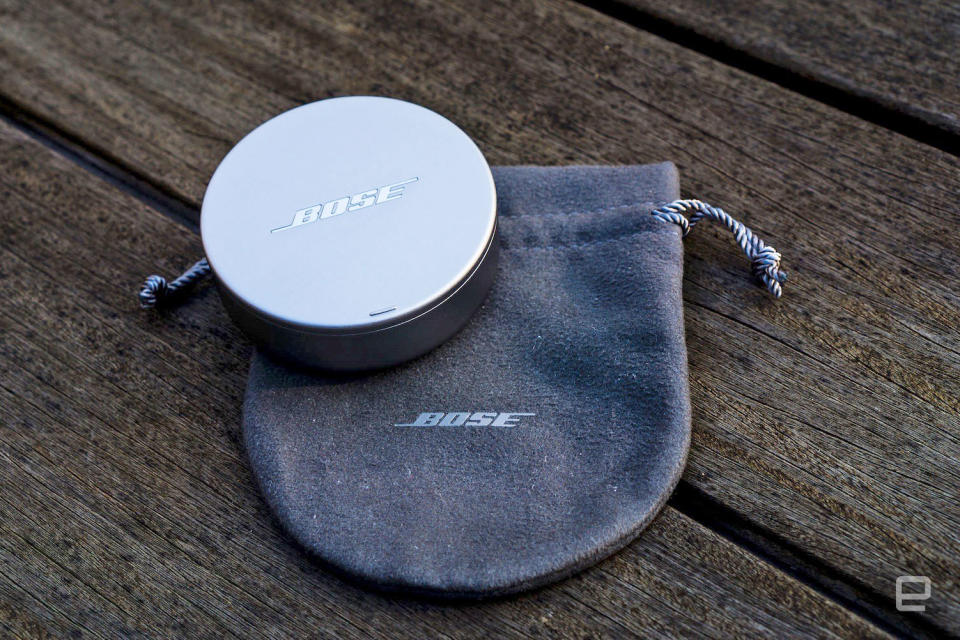
The packaging is the sort of quality you'd expect from Bose. Once you open the box, you're greeted with the shiny white Sleepbuds nestled in a silver case. Lighting on the case indicates how much charge they have (one to five dots) and whether the Sleepbuds are currently charging. The case slides open smoothly and closes with a satisfying click, holding the earbuds secure so they don't jostle free from the charger if you're traveling. They come with two additional ear-tip sizes (with attached wing tips) to ensure a snug fit. The wing tips are key -- they're what keep the earbuds secure over the course of the night. There are also a micro-USB cable and AC adapter included for charging as well as a soft travel bag you can put the case in to prevent scratches and dings.
The earbuds have a 16-hour battery life, and the case provides a full charge. That means you can take the charging case and buds on a three- or four-day trip (depending on how much you sleep) without having to worry about packing a charging cord. They take about eight hours to charge fully, so you'll need to get in the habit of putting these back in the charger as soon as you wake up.
Setup
Setting up the earbuds was as simple as downloading the Bose Sleep app and following the on-screen instructions. I had my earbuds paired to my iPhone in no time; they are also compatible with Android devices.
Charging the Sleepbuds was another matter. The case certainly looks sleek, but it's finicky to say the least. The earbuds must be placed in exactly the right position or they won't charge. There are magnets to help guide you, but that doesn't guarantee contact. It usually takes a nudge or two to get them to actually start charging. And if you're not paying attention, this could be easy to miss. On the plus side, the magnets make sure the earbuds stay in place once you get them charging.
In use
Once your Sleepbuds are charged and you're ready for bed, it's time to fire up the app. Everything is controlled from the app. And I mean everything. If you aren't in the habit of keeping your phone by your bed, this can be frustrating (or if you just don't want to look at a screen at 2 AM). The lack of physical buttons on the case or the buds to control volume, switch white noise sounds and snooze alarms is a major oversight.
You can choose from 10 different preloaded sounds to fall asleep to. I'm partial to Cascade, which mimics a waterfall. The Warm Static sound (which is Bose's version of regular white noise) also works for me, but I find that it's much too quiet to actually block out significant noise, even at high volumes. The Sleepbuds' sounds are designed to stay low enough that they won't damage your hearing, even with long-term use. This means that those of you trying to block out a human chainsaw are probably out of luck.

You can also set an alarm (or multiple repeating alarms) through the app and choose from preloaded wake tones. It offers the ability to customize different repeat days. If your device becomes disconnected from your phone over the course of the night, your alarm will still go off as scheduled. However, placing the Sleepbuds in the case will dismiss any active alarm.
There are two major complaints with the Bose Sleepbuds: You can't add your own custom sounds, and you can't use them as regular earbuds. That being said, the entire point of the Sleepbuds is that they are as small and unobtrusive as possible so you can sleep comfortably on your side. I'd imagine that music wouldn't sound good on them, considering how tiny they are. And the fact that they are a single-function device makes for much, much better battery life. Still, if you're dissatisfied with the range of sound options, Bose does promise to make more available in the future through software updates.
The sound quality is respectable, but you can tell where some of the nature sounds loop. That's a fairly common problem with noise machines, but for the price you're paying, I'd expect a company like Bose to deliver more.
Now, it's worth noting you aren't streaming sounds from your phone -- they're actually preloaded on the earbuds. This means better battery life for your earbuds (and your iPhone) while also preventing noise dropouts and other issues that could wake you up over the course of the night. However, it also makes the lack of physical controls extra frustrating.
Comfort
The Bose Sleepbuds fit extremely comfortably into my small ears. They fit snugly, and while sometimes they work themselves a little loose over the course of the night, I've never had an issue with them falling out. I'm normally a stomach sleeper, but I've been side sleeping during my pregnancy. The first few nights, I woke up with slightly sore ears, but I got used to them pretty quickly. Even if you're a side sleeper putting the weight of your head on the Sleepbuds, they're comfy to wear.
I've tried both foam and wax earplugs to block out noise while I'm sleeping. The Sleepbuds are much more comfortable than foam, which doesn't penetrate far enough into the ear canal to make side sleeping comfortable (small ears, remember?) and often falls out over the course of the night. The comfort is on par with wax earbuds, but those don't make noise, so...
Once the Bose Sleepbuds are in and the sound is cued up and the alarm is set, I drift off to sleep quickly. Beyond being a light sleeper, my anxiety often ensures that I have trouble falling asleep. The Sleepbuds have all but eliminated that problem. It's gotten to the point that once the Sleepbuds go in and the noise starts, my body immediately relaxes. When I wake up in the night, as women often do in the third trimester of pregnancy, the Sleepbuds lull me right back to sleep. I expected these to block out the external noises and they do that well, but I didn't expect them to also calm my thoughts to make it easier to sleep.
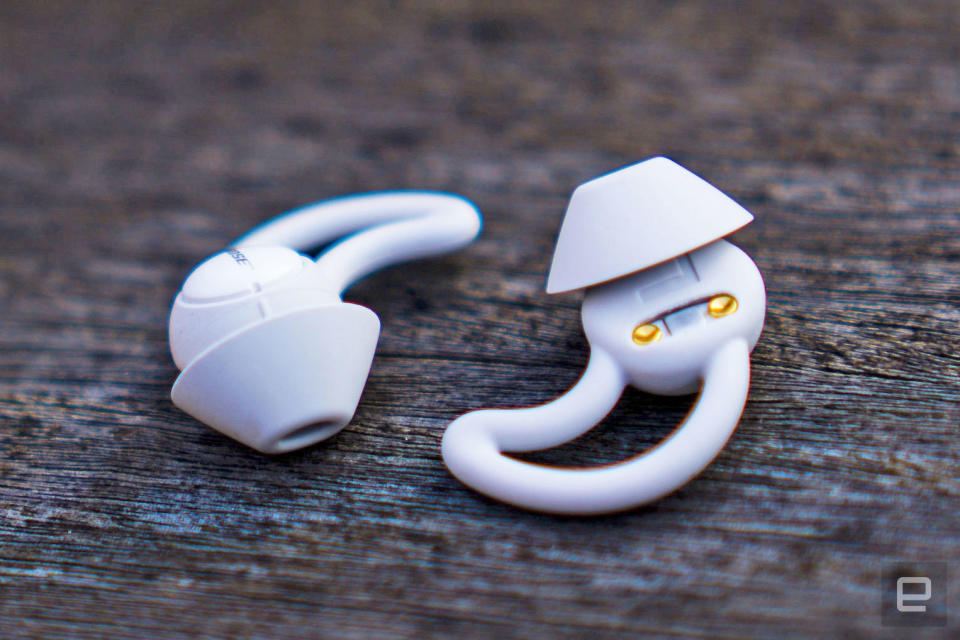
There is one issue with comfort: the white plastic part of the earbud that protrudes from the ear tips. When you're lying on it, it can make a strange rubbing or scratching sound. If you're not moving around much, it's not a big deal. But if you're tossing and turning, it can become extremely obnoxious. Usually I deal with it by adjusting the angle of my head and it's fine. But simply coating the Sleepbuds with a softer material rather than making it out of hard, shiny plastic could have avoided this entirely.
The build quality on these Sleepbuds is solid, but I've run into some hiccups. Sometimes, earbuds won't charge properly, though taking the earbuds off the charger and putting them back on does the trick. I've made a habit of checking on them in the afternoon, just to make sure they're getting a proper charge. Again, considering the price, this isn't something I should have to keep in the back of my mind. The connection can also be finicky. Putting them back in the case and taking them out to get them fixes things, but when it's late and I just want to go to sleep, it's frustrating.
Competition
There isn't much competition if you're talking strictly about earbuds. You can purchase a white noise machine, which isn't nearly as effective at masking the outside world (as I know from using multiples at once). There's also the option of playing white noise through your phone via one of countless free or paid apps.
If playing white noise through an external speaker isn't sufficient, there are also headbands you can buy that mask the hard plastic of regular earbuds and make it easier to sleep. Those usually connect to your phone (or whatever MP3 device you choose to use with them). They're much less expensive but also much less comfortable and don't have the modulation that Bose includes to prevent hearing damage.
If you're going decidedly low tech, then you can also try foam or wax earplugs. While these block out some sound, they don't have the masking capabilities of white noise.
Conclusion
The Bose Sleepbuds aren't perfect. They're pricey, and there are some glaring omissions -- like physical controls. But I bought these once, and if I misplaced them, I'd buy them again without hesitation. I can't overstate the difference these have made in the quality and amount of sleep I'm getting. That alone makes them worth the price. You might not be OK with the compromises necessary, but to me, they're a small price to pay for a good night's sleep.

